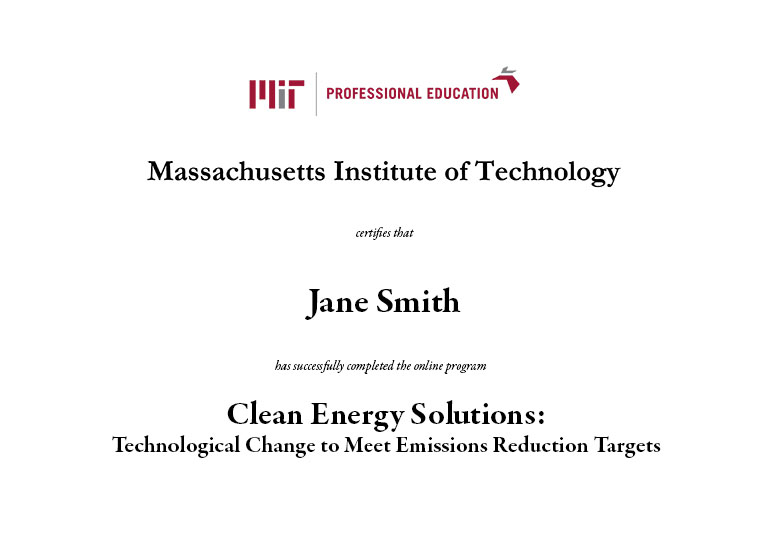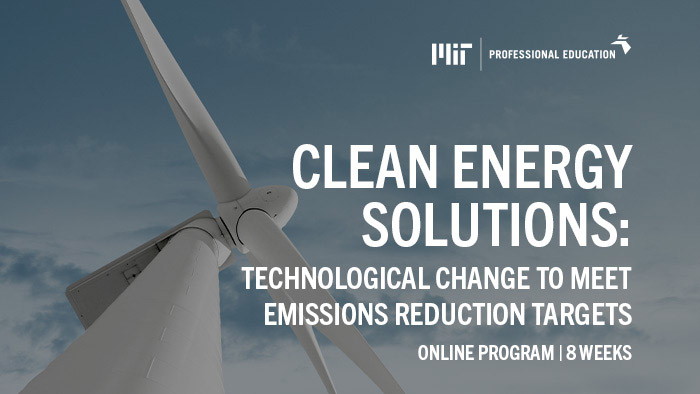Clean Energy Solutions:
Technological Change to Meet Emissions Reduction Targets
Why focus on data-informed clean energy innovation?
To avoid the worst effects of climate change, greenhouse gas (GHG) emissions need to fall faster than they have risen for over a century. To do so, a collaborative effort has begun between nations and an increasing number of organizations around the world to set emissions reduction goals and accelerate progress toward climate change mitigation targets. At the center of this task lies data-informed analysis, which is crucial in the race to reduce emissions in a rapid, cost-effective way.
Finding effective strategies for climate change mitigation through data-informed analyses are essential. Using these insights to make strategic decisions will help secure a healthy future for our planet by supporting a transition toward clean energy systems. If done right, this transition will offer opportunities for economic growth, job creation, and a more sustainable future for us all.
85%
After a 85% cost decline over the past decade, solar photovoltaic systems are among the most cost-competitive energy resources on the market.
Source: Delotitte
8%
An 8% increase in renewable capacity was witnessed in 2022, reaching almost 320 GW.
Source: International Energy Agency
3.3 to 3.6 billion
Between 3.3 and 3.6 billion people already live in settings highly vulnerable to climate change.
Source: Intergovernmental Panel on Climate Change
An online course for addressing climate change with data-informed clean energy advancement
MIT Professional Education’s online course Clean Energy Solutions presents a holistic and quantitative picture of climate change solutions—including hardware—to meet emissions reduction targets. This course focuses on current GHG emission issues, targets, public initiatives, modeling, and the advantages and disadvantages of existing sources of renewable energy.
Being deliberate about clean energy technology plays an essential role in addressing climate change and creating economic opportunities that help support human well-being around the world.
As participants leverage data to analyze and compare energy systems against climate mitigation goals, they will also strategize about key innovation opportunities for their organizations.
Throughout this course you will
1.
Analyze the scale of the climate change mitigation challenge using current and historical contexts of energy supply and demand technologies.
2.
Compare energy conversion and storage technologies based on performance metrics such as cost, carbon intensity, and resource limitations.
3.
Assess a variety of approaches currently taken to model carbon emissions reduction scenarios and the role of energy systems.
4.
Analyze technological change and optimize technology portfolios for your organization.
5.
Estimate the rates of change needed in determinants of greenhouse gas emissions.
6.
Identify effective strategies for innovation on clean energy and other climate solutions.
In addition, you will receive a Certificate of Completion
All the participants who successfully complete the online course Clean Energy Solutions: Technological Change to Meet Emissions Reduction will receive an MIT Professional Education Certificate of Completion. Furthermore, participants will receive * MIT Continuing Education Units (CEUs)*.
To obtain CEUs, complete the accreditation confirmation, which is available at the end of the course. CEUs are calculated for each course based on the number of learning hours.
* The Continuing Education Unit (CEU) is defined as 10 contact hours of ongoing learning to indicate the amount of time they have devoted to a non-credit/non-degree professional development program.
To understand whether or not these CEUs may be applied toward professional certification, licensing requirements, or other required training or continuing education hours, please consult your training department or licensing authority directly.

This course is designed for
Professionals from a multitude of backgrounds interested in climate change mitigation efforts and innovation opportunities. In this course, participants will examine the numbers and science behind climate change mitigation targets and analyze solutions from engineering, policy, and business. The professionals poised to benefit most from the expertise and skills shared through this course include:
- ENGINEERS AND TECHNICAL PROFESSIONALS
looking to take a data-informed approach to devising climate change mitigation solutions that are informed by an understanding of the role and evolution of various energy technologies.
- POLICY CHANGEMAKERS AND ADVISORS
at local, national, and international levels who are interested in acquiring data-driven insights into the climate change mitigation opportunities found in clean energy technologies and beyond.
- R&D, FINANCE, AND INVESTMENT MANAGERS
seeking insights into how to best optimize their energy-related portfolios through better anticipation of technological breakthroughs in the field.
Meet the instructor of this course
PROF. JESSIKA TRANCIK
Professor, Institute for Data, Systems, and Society, MIT

“Mitigating climate change is unavoidably linked to developing affordable, low-carbon energy technologies that can be adopted around the world.”
Learn more
Jessika Trancik is a professor in the Institute for Data, Systems, and Society at the Massachusetts Institute of Technology. Her research examines the impacts of technologies and the reasons behind technological change. Trancik has developed theory and predictive models to understand why some technologies improve faster than others, and what technology features enable rapid innovation. In particular, her work focuses on accelerating clean energy development by informing decisions made by engineers, policy makers, and private investors. This work spans all energy services including electricity, transportation, heating, and industrial processes. Trancik’s theories and models have been applied to new and developing energy technologies, such as solar energy and batteries, and to electricity and transportation systems.
Her models have also been used to inform government innovation policy, and applied in diverse industries, including finance, healthcare, manufacturing, software, and consumer products. Trancik’s work has been published in journals such as Nature, Proceedings of the National Academy of Sciences, Nature Energy, Nature Climate Change, and Environmental Science and Technology, and has been featured by news outlets such as The New York Times, The Washington Post, Financial Times, and NPR.



